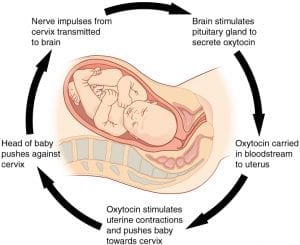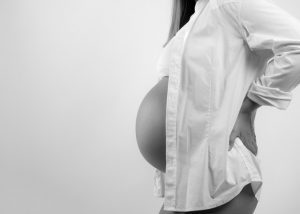If you’re a first-time mom, then this article will benefit you greatly. We will be discussing a whole lot about something that no pregnant woman can ever NOT go through – contractions. You’ll want them to go away, but you know you need them to get you through labor and delivery, and finally seeing your baby. Knowing what the signs of labor look like will help you to determine if it’s time to call your doctor or if you could just be experiencing false labor. If you’re unsure, that’s ok. But, having some idea of what to expect when your baby is ready to be born is very important.

A pregnancy contraction is an important sign to watch out for when you’re about to deliver and will go into labor. And although not all contractions mean that you’re there, they serve as a warning sign that something about your pregnancy needs your attention. The problem comes when you can’t tell if you’re having real contractions or if you’re having something called Braxton hicks contractions. It is imperative, therefore, that every woman who plans to get pregnant must know how these uterine contractions feel like, and in the first place, what they are.
Let’s read through this post and learn what we must about the topic.
Pregnancy Or Uterine Contractions
Throughout your pregnancy, you’ll be feeling your stomach constrict or harden, and then eventually relax. Dr. Paul du Treil, director of Maternal And Child Health at Touro Infirmary says, “The uterus is exercising for the grand finale.” He adds that these pregnancy contractions are an introduction to the special event, the body’s way of preparing you to push your baby out of you and into the world. When your uterine muscles tighten, and your stomach hardens, your baby is guided towards the appropriate position for delivery. Essentially, your body is performing practice contractions to get ready for the real thing. Sometimes, these can resemble real labor contractions, however, other times they feel more like menstrual cramps.


As you go through the pregnancy and then through labor, your contractions progress from the feeling of minor menstrual cramping to stronger and more severe painful tightening. For some, it may just feel like a huge poop is about to come out of the anus, which is a sensible feeling because the muscles we use when we push out a bowel movement are the same muscles that we use to push our baby out. Real contractions, true labor contractions will progress and get more and more painful throughout every stage of labor. When you get to active labor, the last of the stages of labor, this is when things get really intense. The baby is progressing toward its lowest point in the birth canal and it’s getting closer to the time for pushing.
Different Types Of Pregnancy Contractions
- Early Contractions
These are contractions that pregnant women experience during the first trimester. They can occur as a way of their bodies adjusting to the pregnancy. The ligaments are beginning to stretch, which may be the reason for the contraction. Gas pain, constipation, and dehydration may also result in contractions. Most of these will feel about the same as menstrual cramps.
You can do a simple test to know if you’re going into labor or not. Just lie down and touch your stomach, where your uterus is located. Let your hand feel the whole uterus. If it’s hard all over, then you’re having cramps. If some parts are hard and the others are soft, then perhaps the baby is moving around your tummy.
If early contractions are accompanied by spotting, you must consult your doctor right away to make sure that a miscarriage doesn’t happen.


- Preterm Contractions
Pregnant women also experience spontaneous and irregular contractions after the 34th week. These are known as Braxton-Hicks contractions. These are supposed to be painless contractions and are sometimes called ‘practice contractions’ since some doctors believe that these are the womb’s way of preparing itself for true labor and delivery. They usually last for a minute, and they do not increase in intensity. If you think you’re having Braxton-Hicks contractions, you don’t need to worry. Try to relax, elevate your feet, or simply lie down on your left side. Also, try drinking a glass of water. They will eventually disappear.
However, if you feel that your uterus is regularly contracting, like every five or ten minutes, you may be having early labor. Do call or visit your doctor or doula as soon as possible.
- Back Contractions
Real labor contractions can result in back pain, which can start from cramping or dull pain that radiates to your uterus, and then progress to more severe distress at the lower back area. This may be what is referred to as back labor, characterized by an excruciating lower back pain.
Back labor is usually felt when the baby moves as it positions itself towards the vaginal canal. When the baby’s head is facing upward, this sometimes puts added pressure on the woman’s back, causing intense pain in that area. Unfortunately, back labor pains don’t subside for some women, so they will need to ask for help from their doctor for some safe medications that they can take to help with the pain. If there are drug-free means to do this, the better.
Back contractions can certainly be one of the signs of labor. They are often real contractions that are felt whenever labor begins. Especially if you’re in your 37th week of pregnancy or beyond, you should take notice of anything that feels like back contractions because it’s one of the signs of labor.


- Sex Contractions
If a woman’s pregnancy is healthy or without complications, then sex doesn’t heighten the risk of having premature labor. Orgasms, which may happen with or without sex, don’t usually trigger contractions, but may sometimes cause Braxton-Hicks contractions or minimal spotting. These should disappear in a few hours. However, if spotting or contractions do not stop or there is accompanying pain, decreased fetal movements, or vaginal discharge, these are not normal symptoms and should be reported to the doctor right away.
There have been some reports of water breaking during sex. When your water breaks, meaning the fluid in the amniotic sac is released, this is also one of the signs of labor. Even if you don’t feel like you’re having real contractions yet, you are technically considered to be in preterm labor and are at a risk of infection. Most obstetricians and gynecologists would urge you to go to the hospital once your water breaks. Real contractions are inevitably on their way.
The General Guideline
Your midwife or doula plays a vital role in guiding and teaching you about the types of contractions that you should expect and when to think about heading to the hospital. But as a general guideline, mothers should learn the 4-1-1 rule of labor.
You should head to the birth center or hospital when you notice that your contractions are 4 minutes apart, at least 1 minute long, and have been happening for 1 hour.
Once the regular contractions begin, expect these to increase in intensity and frequency up until you give birth. These are the important details to remember about the phases of labor and how long you’ll feel the contractions:
Early Labor typically lasts for about 12 hours but shorter for mothers who have had previous pregnancies. The contractions come between 5 and 30-minute intervals and last for 30 seconds. For the most part, if your water hasn’t broken, it’s ok to wait until the real contractions get stronger before going to the hospital. Though the signs of labor are there, there’s a good chance you’ll get sent home anyway if you’re having these real contractions but not dilating.


Active Labor usually lasts for three or more hours, and the contractions come every four minutes. They continue for about one minute. During active labor, the signs of labor look and feel more like what you see portrayed in tv shows and movies. The pain is getting bad and the mother is having a harder time dealing with it. Active labor is when many mothers to be ask for an epidural. When active labor begins, the real contractions start to get very painful.
Transition is the shortest phase but is the most severe part of the labor process. The transition phase only lasts for 15 minutes to about an hour, and the contractions appear fast, lasting about 90 seconds. These contractions are a result of the dilatation of the cervix to a full 10cm for the delivery of the baby.
Managing Pregnancy Contractions
Women may all agree that contractions are indeed painful, but they do have a very relevant purpose – to prepare the body for their baby’s coming out into the world. Some mothers-to-be prefer to give birth the natural way, and it is possible. Below is a list of some effective pain relief strategies and relaxation techniques that women can do to prepare them for the big day.


- Acupressure And Massage. These are gentle ways of helping one obtain pain relief and relaxation. The therapist can focus on the painful areas and apply mild pressure that is comfortable for the individual.
- Recreational Walks. They’re probably the safest way to exercise during pregnancy. Walking keeps pregnant women active without harming the baby inside them. It also helps decrease the intensity of contractions when they come. Using a birthing ball for toning activities is also encouraged. You can even do these activities once the signs of labor have already shown up. Some people swear by walking to bring on labor. If you’ve reached the day of your due date calculator and aren’t feeling any real contractions, you can walk for a bit to try and bring on some signs of labor. This is safe all the way through that 40th week of pregnancy.
- Deep Breathing And Meditation. Breathing exercises should be done regularly, as one can significantly benefit from these before and during delivery. Meditation also calms the mind and body. These are techniques that can be used pre pregnancy, pregnancy duration, and while having real contractions during labor.


- Choose a Mantra
- These are positive phrases that one can say to herself to instill healthy and encouraging thoughts. They have been used by people who need enlightenment in every aspect of their lives – business, love, relationships, and of course, are very helpful for pregnant women.
How about you? Have you been keeping track of your contractions lately? Why don’t you try these strategies above? Let us know if they work for you! If you have anything to add, let us know how you knew when you were having real contractions. What were the signs of labor that appeared for you? Or, just share anything else that might help other mothers about to give birth.
FAQs
How do you know if you are having a contraction?
Pregnancy contractions are strong, and they have a specific pattern. Your water may break, and your lower back and belly may hurt as well. The American College of Obstetricians says that if you drink a large cup of water or two and you are able to slow the contractions down and get some sleep, then it’s likely false labor. If your feeling something like pre pregnancy menstrual cramps, it’s probably not time to go to the hospital quite yet.
How do pregnancy contractions feel when they first start?
Pregnancy contractions start when you feel pain in the back. The sensation can move to the lower abdomen, its intensity increasing gradually.
How early can contractions start in pregnancy?
First-time mothers may experience contractions as early as 16 weeks. There are a lucky few, however, who do not feel it at all.
Are contractions regular during pregnancy?
Yes, pregnancy contractions is normal. Mild sensations may be experienced from the fourth month and transition into stronger contractions as the due date comes near.
Where do contractions hurt?
You feel the contractions in the lower back and abdomen. There may also be a distinct pressure in your pelvis as the uterus contracts.


Do contractions feel like poop cramps?
Yes, contractions technically feel like poop cramps, especially when you start pushing. This is why mothers typically cannot help but do #2 during labor.
Can you be in labor and not know it?
Yes, you can be in labor and not know it. Sometimes, if you get Braxton Hicks contractions often, you may not realize it when you are already experiencing real contractions. Women often mistake the signs of labor for something else.
Can contractions be painless?
Yes, not all contractions are painful. The pain may start when the baby is close to coming out.
When should I go to the hospital for cramps during pregnancy?
You should go to the hospital when the cramps are continuous or too painful. But even if it is mild, make sure to contact your OB-GYN, too.
What is silent labor?
Silent labor entails that no one in the room can make a sound as the mother starts pushing the baby out of her womb. It is mandatory in the Scientology doctrine.
Last Updated on January 11, 2023 by Rejie Salazar
DISCLAIMER (IMPORTANT): This information (including all text, images, audio, or other formats on FamilyHype.com) is not intended to be a substitute for informed professional advice, diagnosis, endorsement or treatment. You should not take any action or avoid taking action without consulting a qualified professional. Always seek the advice of your physician or other qualified health provider with any questions about medical conditions. Do not disregard professional medical advice or delay seeking advice or treatment because of something you have read here a FamilyHype.com.